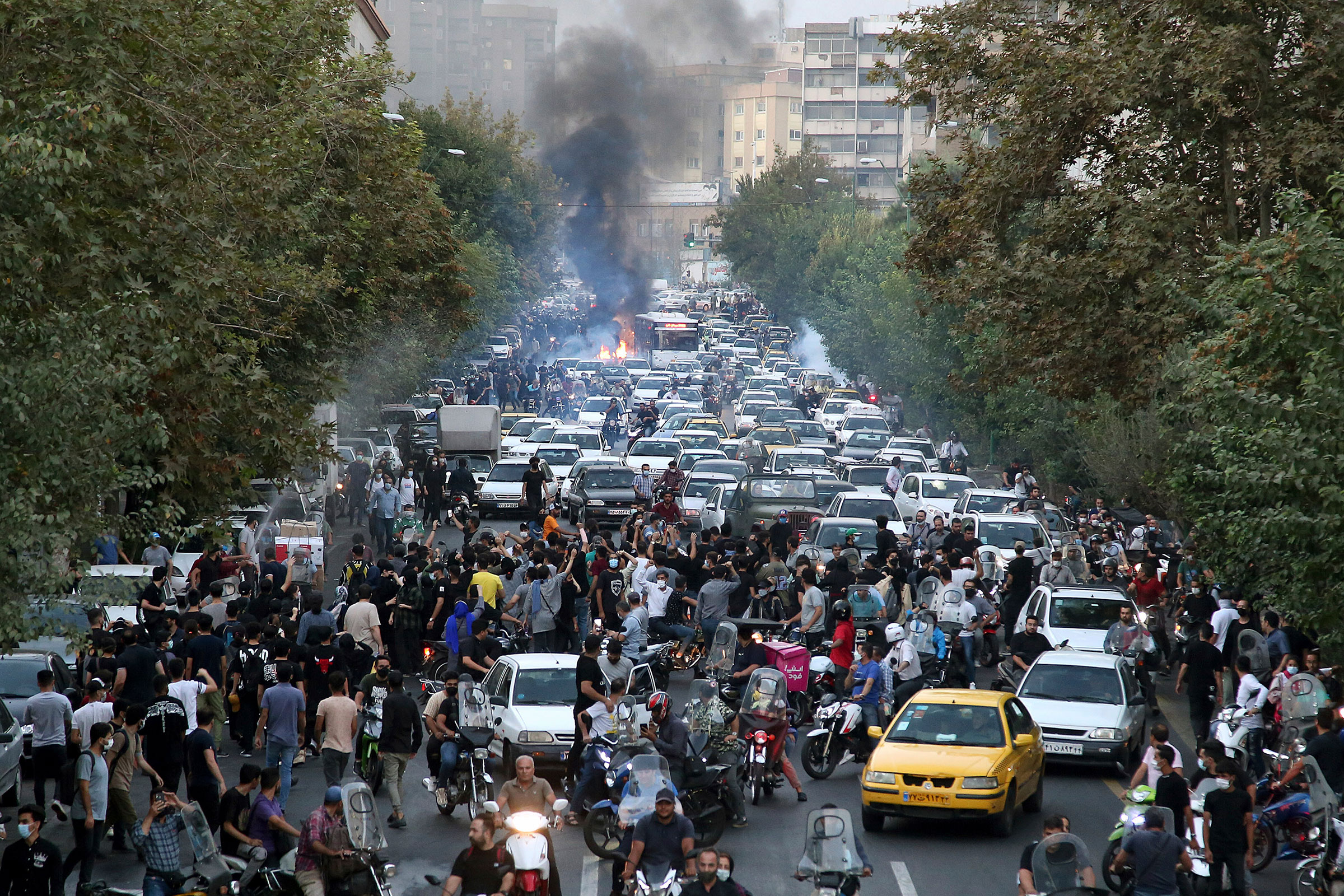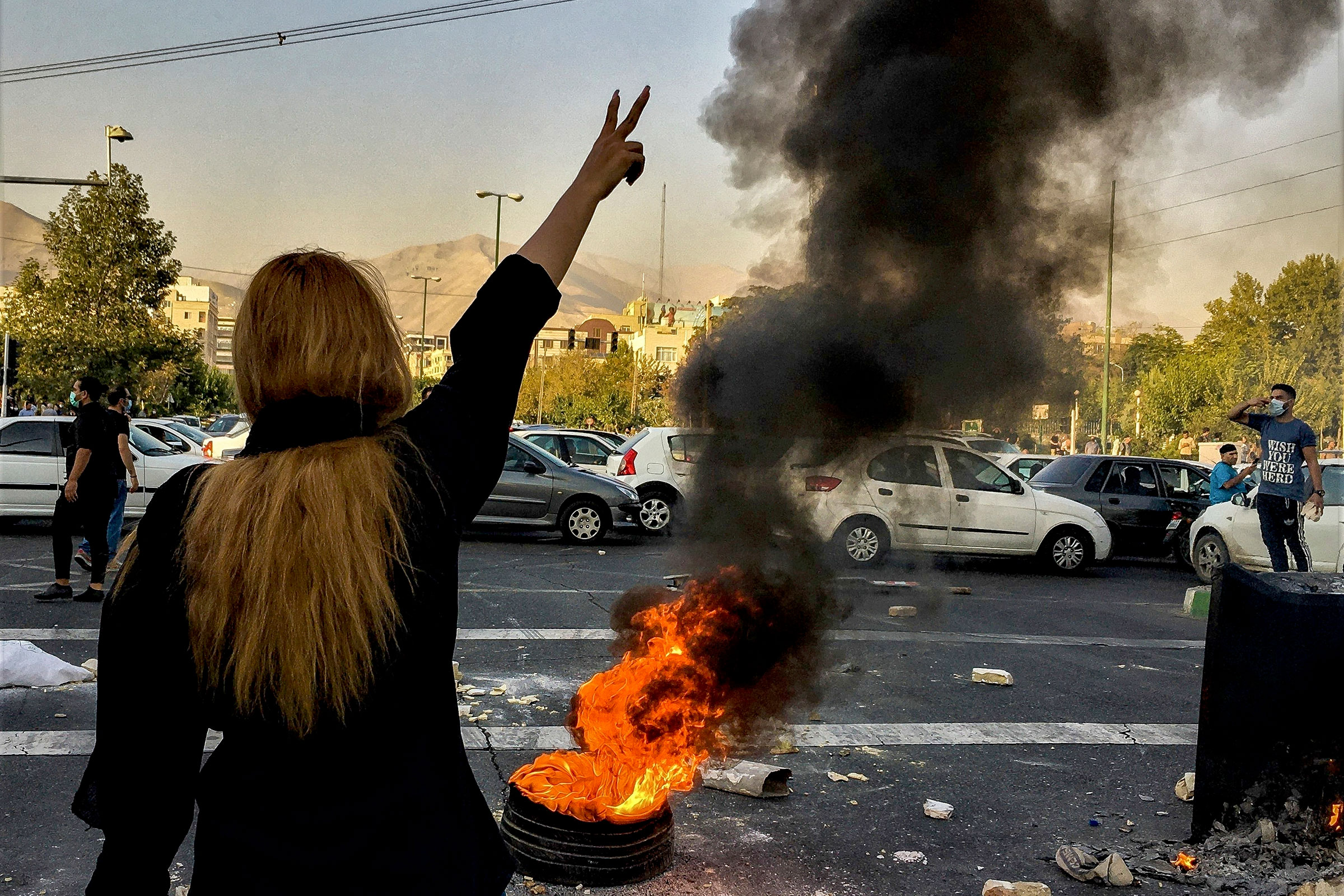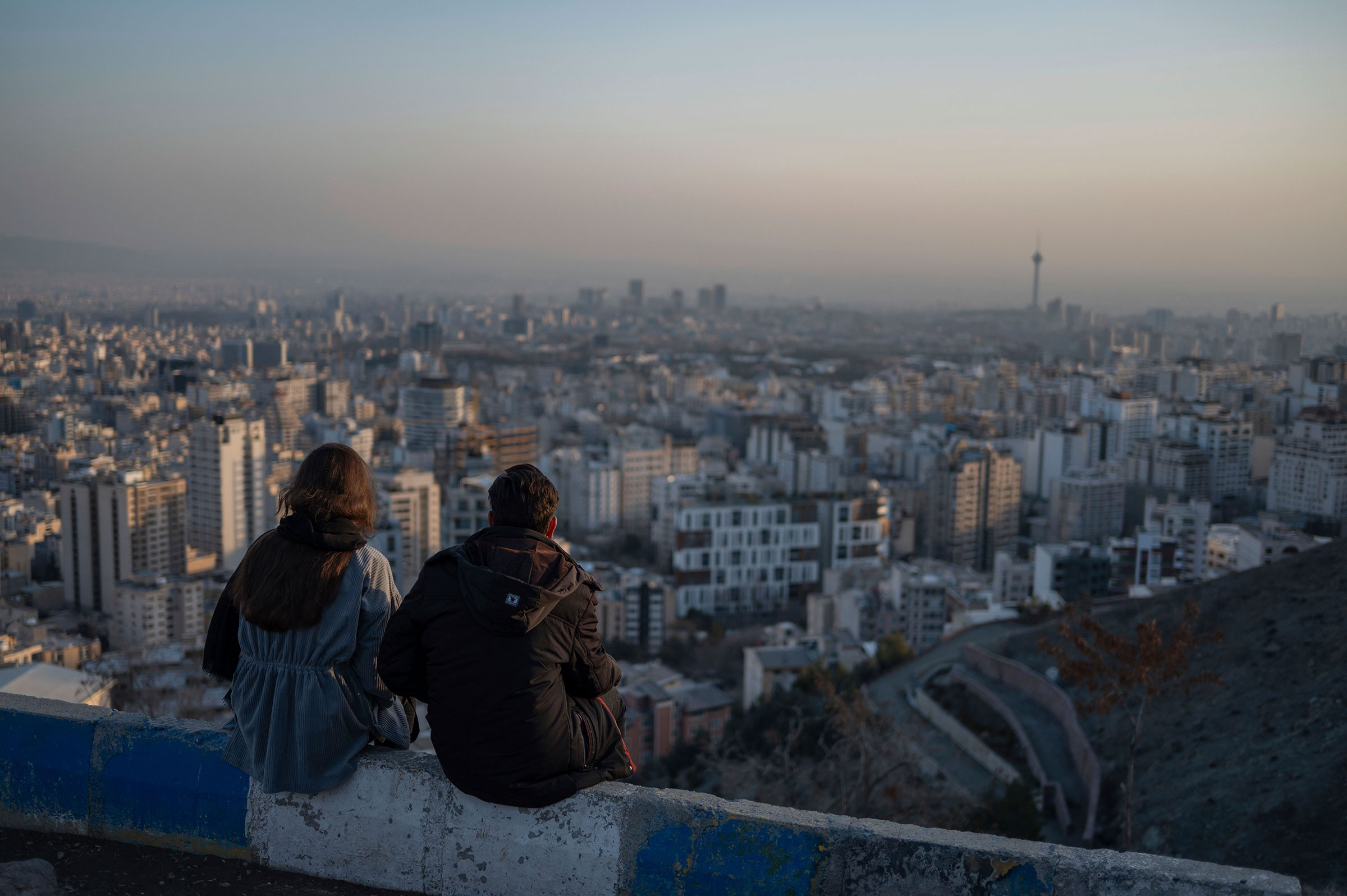Revolutions do not happen only in the streets. Yet the outside world knows the uprising in Iran almost entirely through footage uploaded from camera phones—the thousands upon thousands chanting for the fall of the regime in cities and towns across the country, and the regime answering with batons and shotguns.
There has been no window into the kitchens and courtyards where the country’s fate will be decided.
“I did not think a country could change so much in three months,” says journalist Kay Armin Serjoie, reflecting on returning to Tehran last September after a summer in Germany. Serjoie, who has covered his native country for more than two decades, was not allowed to work as a reporter while he remained in Iran through the arc of the uprising—from the incendiary outbursts of October and early November, through the cold days of December and January, when the regime largely reclaimed the streets and protesters went to ground.
But he remembered what he saw. And, since returning to Europe in the new year, he has written it down:
On an October night, at least 600 security forces are arrayed down a two-mile stretch of Tehranpars Street that has been a focus of protests for weeks. Armor-clad police special forces hold intersections. Revolutionary Guards on high-powered motorcycles swing clubs at protesters who stand their ground. And rotund, middle-aged basijis—dragged from behind desks, and slapped into a helmet and camouflage vests—stand outside mosques and government buildings. Plainclothes agents walk among the crowd, summoning the uniformed forces and their tear gas whenever more than a few score young people gather to chant slogans.
The activists, meanwhile, are overwhelmingly young. Many of the women let their hair flow free.
Read More: Heroes of the Year—The Women of Iran
More from TIME
Apart from the two sides, on what everyone knows is a battlefield, a bigger group nonetheless circulates—an almost unending sea of young families, elderly couples and passersby, some just walking up and down the street, some sitting in their cars in the traffic. They are not shouting any slogans, not protesting anything, yet they brave the tear gas, the charges by security forces, the shouts to move along. They act as if it were just another evening and they’re out for a spin on the streets, window shopping, but they’re also giving cover to protesters—to disappear among them, or hop onto cars, or into shops, to escape the frenzied charges of security forces.

Then this watchful sea—the silent majority known in Iran as “the gray caste”—fills the space vacated by the fleeing protesters, almost as if none were ever there. Whenever a plainclothes agent singles out a protester, cornering him or her till reinforcements arrive, the standstill cars commence honking, nonstop. Passersby suddenly become immobile. Shouts of “Let them go!” rise to deafening levels, stunning the security forces, and many a time giving the protesters just enough time to slip away. When that happens, traffic begins to move, passersby resume strolling, and suddenly shop windows become interesting again.
This goes on for hours, until the basij and Guards, ground down by the time and the realization that they are surrounded only by antagonists, grow either lethargic or so agitated that at times they fight among themselves.
Meanwhile, the people on the sidewalks and in the cars—the people with responsibilities, with families to support; the people on whom the future of Iran will pivot—bide their time, waiting for the protests to produce leadership, specific objectives and definite plans. At which point, they just might step in and risk what little the Islamic Republic has left them.
Some make their feelings known. At an all-female gym, the cleaning lady is ecstatic every time she sees someone enter without any headcovering. “You are so beautiful, you make the city so beautiful,” she says, fully garbed herself in traditional hijab. “You’ve even made life beautiful. I never dared to talk back to my father, but ever since this has started my daughter stands up to her father whenever he is being unfair, and, just imagine, he actually listens to her now. Who would have thought that possible?”
At the check-in desk, the attendant asks: “Are you Kurdish? You are so brave. Every night I watch videos on Instagram and Telegram showing how Kurdish cities are resisting the regime. It’s so sad, so sorrowful what’s being done to them.”
In the past, the divisions in Iranian society—of class, and ethnicity—helped the regime, which played on nationalism with fears that the ambition of the Kurds of the west, or the Baluchs in the southeast, was separatism. Not this time. In Zahedan, the provincial capital of Baluchistan, protesters chant, “From Zahedan to Kurdistan, I will give my life for Iran.” And the sonic ache of the “Baraye” protest song wafts from windows across the entire country. A young man named Shervin Hajipour wrote the ballad of the uprising from the social media posts of fellow Iranians listing the ways life had become intolerable. Just as #MeToo helped women across the world realize they were experiencing the same abuse, Baraye helped Iranians in all corners of the country find each other.
Read More: The 100 Most Influential People of 2023—Shervin Hajipour
But not everyone is comfortable saying so out loud. As security forces scramble from protest to protest in September, then October, then November, it does not go unnoticed that they often arrive in the refrigerated trucks of Mihan, a dairy with ties to the government. Calls go out to boycott the brand.
At a corner grocery in the capital, the father and son owners who take turns behind the counter are always happy to talk about traffic, sports, Tehran’s polluted air. They never talk politics. Yet, suddenly, their dairy case no longer contains Mihan milk or cheese. Why?
“They were returned since their sell-by date had passed,” the son replies, detachedly. “Our customers don’t buy products like that.”
Every night at 9:00 the shouts begin. From rooftops, balconies, and windows of dark rooms, women and men, and sometimes even children, huddled into the dark recesses to avoid inquisitive eyes, shout “Zan, Zendegi, Azadi” (Woman, Life, Freedom), followed by “Death to the Islamic Republic” and “Poverty, Corruption, High prices, Onwards to the Overthrow.” It started days after Mahsa Amini died in police custody, at age 22, arrested for how she wore her headscarf. Sometimes the chanting goes on for an hour.
In his penthouse apartment, a retired officer in the Revolutionary Guard Corps brushes it off. “This is just to let people let off steam,” he tells his neighbors. But as days pass and more people go into the street, he warns that security agencies are noting the main “instigators.”
Then, one October night, his own neighbors join in. He dashes into the building courtyard in a frenzy, “You’re breaking the building regulations!” No one heeds him. He calls out a neighbor by name. “Ms. —. you can’t do this! Be quiet! Stop shouting!”
“It’s none of your business!” she shouts back. The entire street has fallen silent, people watching to see what transpires. The retired officer presses on, demanding that she stop.
“You know what you are?” she answers. “You’re just a little dictator yourself, Mr. —” and she uses his name. “Hey everybody, all together: Death to dictators.” The answering chant startles the Guardsman. After a minute or two of it, he walks away.
The next morning, a neighbor asks why he tried to shout down the women. “Because I know my own people,” he replies, growing earnest. “They have guys who they can give a Kalashnikov and 10 magazines and tell them to go into this building, and those guys won’t stop until they’ve shot their last bullet. And it won’t matter one bit to any of them whether it’s men, women, or children they’re shooting, or if it’s me or a protester. So at least understand why I’m terrified.”

After a few weeks in the streets, the protesters also begin addressing the people in the windows.
“Gray caste, support us!” they chant.
And: “We don’t need spectators!”
From the windows, they keep watching.
In a middle-class Tehran neighborhood, a man asks a 19-year-old neighbor why he endangers his life every night by leading chants in the street and writing slogans on walls.
The young man replies: “Since we were born, we’ve seen how the regime has been gradually sucking the life out of our parents with inflation, price hikes, limitations on social and personal freedoms.
“If I have to go,” he says, “I prefer to go fast.”
His generation has never known hope. Coming of age after the death of the reformist political movement that, for more than a decade, held out the promise of a more humane Islamic Republic, Iranians in their teens and 20s have faced both a more resolutely authoritarian regime and the hardships of economic sanctions imposed by the West over that regime’s nuclear ambitions. Saving every Rial from a minimum-wage job, a young person would need nearly four years to buy the cheapest car in Iran, and 44 years for an apartment. Lovers face arrest for holding hands.
Read More: Iran Has a Long History of Political Activism and Protest. Here’s What To Know
The middle-aged neighbor commiserates. He’d participated in protests over the years. But even though the current uprising has reached every corner of Iran, he says, without leaders and a plan it amounts to an “aimless revolt which will end with bloodshed.”
“They say I’m a part of the gray caste, not committing to the revolt, but it’s not that simple,” the man says. “The house I’m living in is not mine, I should have traded in my car years ago, and I’ve been working for more than 20 years. I’m just making ends meet, and I’m worried, if something happens to me, who’s going to put the bread on the table for my wife and kids?
“I’ve seen so much cruelty from this regime, and one thing I know: the Islamic Republic won’t just pack up and leave like the Shah did in 1979. They’ve got nowhere to go. The roads will turn red with blood before we get rid of them. I don’t want to risk my family’s livelihood to no avail, and I don’t want these kids to sell their lives cheap.”
A few nights later, the younger man goes out to spray-paint slogans and does not come home. His frantic parents search prisons, police stations, hospitals, and morgues. The neighbor is moved — for now, only as far as the window, where he joins the nightly multitudes shouting slogans.
“When the time comes,” he says, darkly, “I will avenge the kid.”
The regime is watched closely for evidence of weakness. The evidence is everywhere. Neighborhoods that historically supplied the militias that put down dissent in the past have themselves become hotbeds of protest. Rallies the government organizes to counter the impression it has lost Iranian society are so paltry that state media Photoshops images of crowds, and state television rolls the same footage over and over, like the background behind a running cartoon character. The Supreme Leader, widely rumored to be gravely ill, chides security forces to do their duty.
But the regime is also ruthless. The death toll compiled by human rights groups, 506 by mid-December, does not take in the grievously wounded, uncounted young people shot-gunned in the face or genitals. Young women who have lost an eye to birdshot post their new looks proudly on Instagram. But their assailants speed away. Though most of the 30,000 people who had been detained will eventually be released, they will go home with stories of sexual torture, beatings, and treatment so extreme that several die by suicide after being released.
On a cold December night, the security forces on Tehranpars Street begin closing up shop at 8 p.m. There had been a few protests, a junior officer tells a passerby, “but nothing like the nights in the past months, thank God.” His irate commander steps in to flatly deny any “sedition whatsoever tonight.”
The streets of major cities have seemingly been, to some extent, tamed. And yet, even as the number of protesters has fallen, the gray caste continues to show up to offer them cover. And shop owners who in previous years pulled down metal shutters at the first sign of trouble are still open, every night—like the stand selling the Persian soup of noodles and beans known as aash around the corner from Tehranpars a couple of nights earlier. A young man, sweating and out of breath from fleeing riot police, pauses to share his frustrations. He sounds like The Kid’s middle-aged neighbor.
“The problem is there is no direction, no planning,” he says, “It’s almost become sporadic, and with the murder the regime is committing every night, the price is too high for what is becoming a blind revolt.”
Iran’s government is called “theocratic” because clerics organized it after the 1979 Revolution, which unwound across most of a year before the Shah fled. But the regime is best understood as an intelligence-security state. Inside Iran, prominent dissidents and natural leaders—scores of activists like Narges Mohammadi, Bahareh Hedayat, and the rapper Toomaj Salehi —have been either bundled off to prison, or so heavily surveilled as to be paralyzed.
“But we had such high hopes from activists and opposition groups in exile,” the protester says. “We thought just like Ukraine they would be able to get Elon Musk’s Starlink internet up and running by now. At the least they could have made some sort of a coordination committee to organize the protests, to come up with a plan on how to go forward.”

Read More: Inside the Clandestine Efforts to Smuggle Starlink Internet Into Iran
Starlink dishes, which would allow dissidents a way to avoid state surveillance, are outlawed in Iran. But so were the satellite TV dishes that became a fixture of Iranian life, with popular channels operated by exiles who, for decades, urged the people to rise up. Now that the people have done just that, the protester says, the exiles “spend their time arguing over the name and parameters of a revolution that they’ve done nothing for.”
And yet every night at nine, the windows still fly open. And the chants begin.
“It’s not over,” says another protester, a literature student in her early 20s. “The fire is still there. It’s what in Farsi we call ‘fire under the ashes.’”
“In the beginning we would gather on campus and start from there,” she says, “but gradually with all the pressure and violence and arrests, the internet blocked like never before, and the campuses being shut down, we’re no longer able to coordinate. We just go out in ones and twos, and hope to still be able to speak to each other the next morning.”
Over the previous three months, two of her classmates had been wounded by shotgun blasts, and nearly a dozen from her university simply disappeared. But she’d been on Tehranpars Street a few minutes earlier.
“We will go on,” she says again. “Maybe we’ll have to change tactics in the short term. We’ll probably have to adjust to the situation we’re in. But we won’t stop. We’ll keep stoking the embers of this fire until one day, somehow, we can get the masses back out on the streets, get the gray caste to fully commit. And then this fire will blaze so hard it will incinerate this tyrannical regime.”
More Must-Reads from TIME
- Cybersecurity Experts Are Sounding the Alarm on DOGE
- Meet the 2025 Women of the Year
- The Harsh Truth About Disability Inclusion
- Why Do More Young Adults Have Cancer?
- Colman Domingo Leads With Radical Love
- How to Get Better at Doing Things Alone
- Michelle Zauner Stares Down the Darkness
Contact us at letters@time.com
